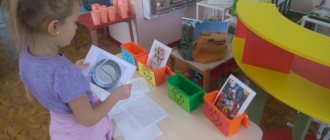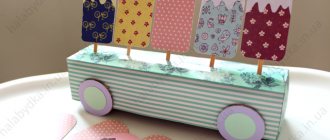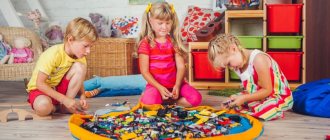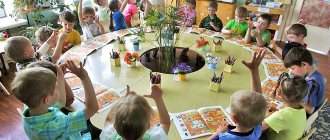Methodological recommendations “Teaching children outdoor games”
Methodological recommendations “Teaching children outdoor games” Methodological recommendations “Teaching children outdoor games”
Annotation:
These guidelines
developed on the basis of the general requirements of the Federal State Educational Standard.
These methodological recommendations provide training
material for preschool teachers, physical education instructors, and parents of students.
The contents of the manual are possible for study, analysis and organization of practical work in preschool educational institutions. The manual includes the psychological and pedagogical information necessary for teachers and parents, theoretical and practical work, a list of outdoor games
, and approximate long-term planning.
INTRODUCTION
The first years of a child's life are the most charming period. The baby learns a lot, begins to talk, ask questions, observes those around him and imitates them very touchingly. In early preschool age, most of the time the child is engaged in objective activities, but enjoys participating in outdoor games
and game exercises of a motor nature.
A game
occupies a very important, if not central, place in the life of a preschooler, being the predominant type of his independent activity.
movement games are widely used in kindergarten practice.
, singing games and others.
But among the variety of games, especially active games
, in which all
players
are necessarily involved in active motor actions.
All games for children
preschool age games based on movement can be divided into two large groups:
outdoor
games with rules and sports games.
The first group consists of games that differ in content, in the organization of children
, in the complexity of the rules and in the uniqueness of motor tasks. The second group is sports games: gorodki, badminton, basketball, hockey, tennis, football. When working with preschool children, they are used with simplified rules.
In the younger groups of kindergarten, plot-based outdoor games
, as well as simple games without a plot such as traps and fun games.
Plotless games with elements of competition, relay races, and games with objects are not yet available to children. They do not play sports games with children of primary preschool age at all. At the same time, when working with children of primary preschool age, play exercises are widely used, occupying an intermediate place between gymnastic exercises and outdoor games
.
However, currently in preschool institutions there is a tendency to engage in learning
– there is less and less time left for playing and freely communicating with each other.
Relevance: Due to the lack of systematic work in shaping the child’s gaming experience and the inability of teachers to organize a full-fledged game and, as a consequence, its strict regulation.
Target:
Formation in children
preschool age creative abilities and communication skills through the creation of a systematic approach, the most favorable conditions for the inclusion of motor and play activities in the educational process of preschool educational institutions.
Types of innovations:
1. By influence on the educational process:
— in the content of education;
- in forms, methods
educational process;
2. By scale (volume of transformations)
:
- partial, single, unrelated;
— modular (a complex of partial ones interconnected)
3. In terms of innovative potential:
— improvement, rationalization, modification of what has an analogue or prototype (modification innovations)
;
— a new constructive combination of elements of existing techniques
, which have not previously been used in a new combination
(combinatorial innovations)
;
4. In relation to the previous:
— innovation is introduced instead of a specific, outdated product.
— mastering a new type of service, a new program, technology (opening innovation)
;
- retro-introduction - mastering something new at the moment, for the kindergarten staff, but once already used in the preschool education system.
Reasons for innovation:
1. The need to actively search for ways to solve existing problems in preschool education.
2. Imitation of other preschool educational institutions, teachers’ intuitive idea that innovations will improve the activities of the entire team.
3. Increasing demands from individual groups of parents.
II. Main part
Outdoor game
– an indispensable means of replenishing a child’s knowledge and ideas about the world around him, developing thinking, ingenuity, dexterity, dexterity, and valuable moral and volitional qualities.
When conducting outdoor
play, unlimited opportunities are created for the integrated use of various
methods
aimed at shaping the child’s personality.
of the mobile is great
games in the mental education of preschool children. The guys perceive the rules of the game as law; conscious implementation of them forms the will, develops self-control, endurance, and the ability to control one’s actions and behavior.
2.1 Characteristics of outdoor games
Outdoor games
Story games; Plotless games; Game exercises;
Fun games. Folk games
Story games. Games of this type are based on the experience of children
, their ideas and knowledge about the surrounding life, professions, means of transport, natural phenomena, lifestyle and habits of animals and birds.
The plot of the game and the rules determine the nature of the movements of the players
.
In story games
, therefore, the movements performed are mainly imitative in nature.
In story games
Usually the majority of
children portray
, for example, birds, bunnies, and one child or teacher becomes the performer of a responsible role - a wolf, a fox, a cat.
actions are closely interconnected
.
In story games
children are very spontaneous, transforming into the characters of the game, being carried away by it, they repeatedly repeat movements such as walking, running, jumping (bouncing in place and moving forward, jumping from low
objects
, jumping over a cord, line, small cube, crawling, crawling .
Building games for kids has its own characteristics. Thus, performing more complex movements in them should occur in a calm environment, when children’s
no additional signals distract.
Plotless games. Plotless games such as traps and dashes are very close to plot games - they just don’t have images that children imitate, all other components are the same: the presence of rules, responsible roles (traps, tags, interconnected game actions of all participants. These games, just like plot-based, based on simple movements, most often running combined with catching and hiding, etc. However, it should be noted that plotless games require children
greater independence, speed and dexterity of movements, orientation in space than plot ones.
Game exercises. In game exercises there are no game actions of a group of children
, each child acts according to the individual instructions of the teacher, and the fulfillment of motor tasks depends only on his personal capabilities.
Game exercises can be used in physical education classes, especially when conducting individual work on the development of movements outside of class, both with individual children and with small groups.
Fun games. When working with preschool children, so-called fun games and attractions are also used. While not particularly important for physical development, they are, however, often held at leisure evenings and at physical education festivals. Motor tasks in these games
are performed under unusual conditions and often include an element of competition.
Folk games: Folk active
games stimulate active thought, help broaden horizons, clarify ideas about the world around us, improve all mental and physical processes, and stimulate the transition of the child’s body to a higher stage of development.
The game situation captivates and educates the child, and the beginnings found in some games
, dialogues directly characterize the characters and their actions, which must be skillfully emphasized in the image, which requires
active mental activity children
So, folk games in combination with other educational means represent the basis of the initial stage of the formation of a harmoniously developed personality, combining spiritual wealth, moral purity and physical perfection.
2.2. Selection and planning of outdoor games
Movable
games should ensure the diversified development of
children's
, as well as contribute to the formation of their skills to act in a team, navigate in space, and perform actions in accordance with the rules or text of the game.
Therefore, it is necessary to use outdoor
games and exercises that are not only varied in content, but also in the organization
of children
, in the complexity of coordinating movements.
Movable
games must comply with: the content of game actions, rules;
age characteristics of children
, their abilities, skills, knowledge about the world around them, their capabilities in learning new things.
When selecting games, the composition of the group of children
.
Some children
come to kindergarten for the first time at the beginning of the year.
Such children
do not yet have the skill of joint actions in a peer group; some cannot get used to the regime for a long time.
In terms of their motor experience, these children differ from children
who previously attended groups.
The general condition of the group should also be taken into account.
Mobile planning
games depend on the working conditions of each age group: the general level of physical and mental development
of children
, their motor skills, the health status of each child, his individual typological characteristics, the time of year, the characteristics of the regime, the location, the interests of
the children
.
2.3. Preparing for the game
Preparing for the game consists of several important points:
1. Preliminary familiarization of the teacher with the content of outdoor games
. It is necessary to know the games not only of your group, but also of adjacent age groups.
2. Preparation for a specific game. Here you need to know in what conditions the game
: on site or indoors, in a group room or in a hall, with how many
children
.
This will help the teacher think in advance about how to place the players
in the available space so that they can move freely.
In advance, you need to clarify the content of the game, its rules, repeat the text (if it is in the game), think over methods for activating children
, the use of individual aids, toys.
3. Immediately before the game, pay attention to the hygienic condition of the room or area where the game
: in a group room or hall it is necessary to carry out wet cleaning, open transoms, vents or windows.
When conducting outdoor
games in the fresh air, the area should be cleared of foreign
objects
, swept, and if necessary, watered first to prevent dust! Don't limit yourself to just the group platform.
4. Immediately before the start of the game, children can be involved in arranging toys and aids. Such active participation in preparation increases their interest in the game and in completing game tasks.
2.4. Outdoor game management
Despite the fact that children love to play outdoor games
, they cannot organize a game, even one that is familiar to them, on their own. This is typical for the entire period of early preschool childhood.
When carrying out mobile
games, it is necessary to remember to fulfill the basic educational tasks.
One of these tasks is the development and improvement of children's
.
Kids must follow, at least in general terms, the way of performing movements determined by the plot and rules. As children gain motor experience, the requirements for performing movements should increase. The second task is to teach children
to act in a team in accordance with the rules of the game.
It is very important that the teacher is not only a performer of a responsible role in the game, but also just an ordinary participant (a bird, a bunny, etc.)
.
play
with pleasure when adults show interest in all their actions in
games
and actively participate in them, showing an example of the correct execution of movements. The cheerful, affectionate tone of the teacher captivates the kids; their joyful mood is conveyed to them. You need to explain the game to kids emotionally, expressively, trying to characterize the characters using the intonations of your voice. For example, you need to speak about bunnies and birds tenderly, kindly, and about a bear that scares the bunnies - in a low voice, somewhat ruder. When explaining, it is necessary to pay attention to the signals by which children change their actions during the game. Words accompanied by certain movements must be pronounced clearly, without haste: the last phrase of the text should be pronounced somewhat louder if it serves as a signal for a change in movements.
Explaining plot games to children of primary preschool age should be a short, figurative story and evoke in the child vivid ideas about the characters he will portray in the game.
An important condition that arouses children’s interest in the game is the direct participation of the teacher in the game, the manifestation of his interest. The teacher often has to combine managing the game with playing a responsible role, since children of even the second youngest group do not. can still cope well with these responsibilities, although they show great interest in them. The kids are not embarrassed by the fact that the teacher, being, for example, a bear, gives them comments on how to perform movements, reminding them of the rules of the game. They willingly obey his instructions and at the same time perceive him as an active participant in the game.
In the process of moving
During the game, the teacher monitors the implementation of the rules, the relationships
between the children
, and their condition.
All this is very important, since violation of rules, for example, on the part of most children
, or their overly excited state are signs of fatigue.
the children
switched to a calmer activity.
An indispensable condition for the proper management of children’s
is an individual approach to each child during games.
The plots, rules and organization of the proposed games are simple, and they also allow for the completion of tasks in accordance with the capabilities and desires of each child. The main thing is to involve children
in active and useful activities for them, and this goal has been achieved: children practice crawling, obeying a certain rule when performing a task.
In any kindergarten group there are always overly active children who often change types of motor activity. The child does not sit still for a minute: he either runs after the ball, then picks it up and immediately throws it on the floor, then climbs onto a chair, and then starts running around the room without any purpose. Such chaotic, inappropriate actions overly excite the child. In such cases, it is advisable for the teacher to switch the children’s
for a more relaxing activity, a game.
2.5. Creating conditions for games
To carry out mobile
games and exercises in each preschool institution it is necessary to have a variety of physical education equipment, which can be installed both on the site (on group playgrounds and in group rooms. It is widely used in conducting organized physical education classes and
outdoor games
, and also stimulates the independent motor activity
of children
.
2.6. Methodology for conducting outdoor games
Methodology for conducting mobile
games include unlimited possibilities for the integrated use of various techniques aimed at shaping the child’s personality and skillful pedagogical guidance of it.
Of particular importance is the professional training of the teacher, pedagogical observation and foresight. By stimulating a child’s interest in play, engaging him in play activities, the teacher notices and identifies significant factors in the development and behavior of children
.
It is necessary to determine (sometimes in individual strokes)
real changes in knowledge, skills and abilities. It is important to help the child consolidate positive qualities and gradually overcome negative ones.
Methods of conducting outdoor play for children
preschool age is aimed at raising an emotional child who consciously acts to the best of his abilities and has a variety of motor skills.
A prerequisite for the successful implementation of mobile
games is to take into account the individual characteristics of each child. His behavior in the game largely depends on the existing motor skills and typological characteristics of the nervous system. Active motor activity trains the child’s nervous system and helps balance the processes of excitation and inhibition.
2.7. Methodological recommendations for organizing outdoor games for teachers
.
When assigning games, it is necessary to take into account the age of the children
, their health, the level of physical and mental development
of children
, interests, wishes of
the children
.
When determining the magnitude of the moving
The game needs to take into account not only the physical side, but also the degree of emotional intensity of the game.
A large number of participants in the game should not be allowed in a group of weakened and young children
. This deprives them of being active in the game, and deprives adults of monitoring the condition of each child during the game.
It is not recommended to summarize the results of the competition
, relay races immediately after their completion due to a sharp change in the dynamic state of the child’s body that arose during the game into a static one
(during the teacher’s explanation)
.
Therefore, at the end of the competition, before summing up the results, it is recommended
mobility games or exercises
aimed at relaxing the body with children
Children should be encouraged to have correct posture
, beautiful position of the head and torso during walking and exercises, clarity in following the rules of the game.
When assigning roles in the game and issuing commands, you need to take into account the degree of excitability of children
.
With excitable children, the tone of the leader’s conversation should be quiet and stern; with quiet children - encouraging, gentle. Every, even small, achievement in the play of such children should be celebrated
, thereby giving them vigor and confidence in their abilities.
It is necessary to correctly assess the individual characteristics of the child when assigning roles in the game.
You cannot offer games in a row that require long-term concentrated attention of children
, or loads on the same muscle groups, or training the same skill, which leads to rapid fatigue of the child.
It is necessary to dose physical exercise, alternating exercise with rest. Explain the results and motivate them.
During the game you must follow safety precautions.
2.8. Guidelines for organizing outdoor games for parents
.
Preschool children are very active
.
Their movements are fast, varied, and this feature must be used. Children
need to be taught to walk, run, jump, throw, climb, and train their sense of balance.
In the morning, before breakfast, it is advisable to give children the opportunity to play independently.
.
Adults should supervise children's play
preschool age.
It is advisable that parents themselves take part in children’s play at home
. To maintain the child’s interest, the game should be complicated over time and the toys should be changed.
Movable
games are simply necessary for our kids - they have a beneficial effect on the vestibular apparatus, develop coordination, strengthen the cardiovascular system, and develop concentration and attention in the child.
... These are only the main advantages that lie on the surface, not to mention the joy that you will bring to the baby. Don't forget - "MOVEMENT IS LIFE"
.
2.9. Load dosage during the game
The responsibility of the teacher is not only to choose the right and start an outdoor game
, but it is also reasonable to dose it and finish it on time.
The load in the game is dosed by decreasing or increasing the overall mobility of children
.
To regulate physical and emotional stress, you can use the following techniques:
1. Change the duration and number of repetitions of game elements.
2. Increase or decrease the size of the site.
3. Complicate or simplify the rules of the game.
4. Use equipment of greater or lesser weight and size.
5. Introduce short breaks, organize “rest homes”
for
children in games
with continuous actions, etc.
Of course, when carrying out mobile
games, it is difficult for the teacher to take into account the individual capabilities and physical condition of each participant at a given time.
Therefore, one should proceed from the choice of optimal loads. An important factor when choosing the dosage of outdoor
play is the nature of the previous activity and the mood
of the children
.
Intense games should be alternated with less intense ones. With an increase in the emotional state of the players
the load also increases.
Captivated by the game, children lose their sense of proportion, wanting to outdo each other, do not calculate their capabilities and become overtired. They may not feel the onset of fatigue. It is necessary to take into account the age characteristics of those involved, their preparedness and state of health. Sometimes it is advisable to stop playing, although the players
have not yet felt the need for rest.
It is desirable that all players
receive approximately the same load.
It is recommended
the driver from time to time, even if he failed
to “win back”
.
Losers be removed from the game (if required by the rules of the game)
only for a very short time, and it is best to simply give them penalty points.
Particular attention should be paid to physically weak children. They need an individual dosage: shorter distances, easier tasks, less time spent in the game.
3. Study of gaming activities.
children's play activities
preschool age consists of three blocks.
The first block includes methods
for diagnosing physical and intellectual development during the game. The second consists of descriptions of game situations, questions and solutions. The third is a system of tests with different levels of difficulty. The research is carried out by solving the following problems:
Disclosure of diagnostic functions of mobile devices
games and games with rules for the physical and intellectual development
of children
.
Conclusion: Through outdoor games in children
strength and agility, speed and endurance, coordination of movements and speed of reaction, education of kindness and mutual assistance, a sense of camaraderie and collectivism develop. The quality of children's assimilation of physical education program material is improved.
III. Conclusion
A game
is one of the most important means of physical education
for children
.
It promotes the physical, mental, moral and aesthetic development of the child. With the help of outdoor
games, the comprehensive physical development of the child is ensured.
Movable
games create an atmosphere of joy and therefore make the most effective complex solution to health, educational and educational problems.
As a result of the systematic implementation of mobile
games and proper management of them can instill in
children
the most important volitional qualities: endurance, discipline, the ability to regulate their actions, their behavior.
Guided by these methodological recommendations
, educators will be able to fully unleash their creative abilities.
Increasing the level of professional skill of each teacher, the ability to analyze their work, and take a creative approach to the choice of educational methods
will naturally improve the educational activities of preschool institutions.
Many pedagogical problems intersect in the game's patch. This is the relationship between the teacher and children
, the individual and the team, discipline, emotional atmosphere, interest in a specific task and in creative activity in general.
Want to solve these problems? Let's Play
!








